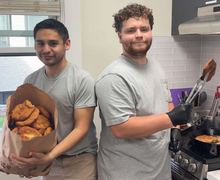New York’s apple orchards are back, better than ever
Lars Jendruschewitz | Photo Editor
Critz Farms' fall harvest celebration allows visitors to handpick their apples. The family-run farm owns more than nine acres of apple orchards.
Get the latest Syracuse news delivered right to your inbox.
Subscribe to our newsletter here.
A couple of years ago, New York apples were in such high demand that there was an extensive waiting list to purchase an apple tree from a nursery, said Patrick Allen, co-owner of Critz Farms. If a farmer wanted to buy a “whip” — a young tree — there was a wait time of up to five years.
“New York leads the U.S. apple industry,” Allen said. “(Apple picking in NY) has been a tradition for something like 300 years, so it draws people from all over the country to come pick apples.”
Due to the efforts of family businesses like Critz Farms, award-winning orchards like Beak and Skiff and researchers from Cornell University, people from near and far travel to central New York every fall for apples, Allen said. After a disappointing season last year, orchards in the region are now making their comeback.
Last year, central New York apple orchards had one of their worst years in recent history, Allen said. With a late frost and a series of cold spring months, apple growing conditions led to Critz Farms losing 95% of its apple harvest.

Lars Jendruschewitz | Photo Editor
After a devastating 2023 apple season, apple orchards have regained their staple status in central New York. No late spring frost led to a great apple crop this year.
After losing so many apples, the farm had to shut down its pick-your-own apple orchards for the season. Allen said the loss was catastrophic, and the farm relied on other agritourism ventures like their pumpkin patch and maple syrup for the remainder of the year.
“We’re lucky in that we’re very diversified, and so all our eggs — all our apples — aren’t in that basket,” Allen said.
This season, weather conditions have been back to normal. With an unseasonably warm October so far, more people are visiting orchards and festivals to enjoy wagon rides, apple picking and cider, Allen said.
“This year we really didn’t have that (late frost) so we started out on a strong note,” Dave Knapp, the treasurer of Lafayette Apple Festival, said. “With the warm and not overly wet summer, but a good mix of sun and rain, it was a perfect combination for a wonderful apple crop.”
Knapp said central New York is an optimal place for apple growing because of its geography, weather and tradition. Apple orchards have been a staple in the area for over 300 years, and NY soil and weather are conducive to new apple varieties like Honeycrisp.
Each year, central New York hosts the LaFayette Apple Festival. Knapp’s parents were on the first festival committee in 1973. He returns each year because of his fond memories of the festival from childhood and the life lessons about community and volunteerism it teaches, he said.

Flynn Ledoux | Illustration Editor
“I pretty much grew up with it, knowing every Columbus Day weekend, mark that date down on the calendar because you’re not going anywhere,” Knapp said. “It just became a passion over the years.”
The festival is about to celebrate its 51st year this weekend and attracts thousands of visitors, including nearly 400 crafts vendors. It only permits local organizations to sell goods, from wood paintings to bags made out of jeans, at the festival.
“It’s one of the later outdoor events that we have,” Knapp said. “One last chance to get out (and) have fun before the weather really starts turning bad and we hunker down for the winter.”
Another reason for CNY’s thriving apple community is Cornell University’s agricultural research programs, like the Agriculture Experiment Station in Ithaca. One of AES’ post-harvest researchers, Chris Watkins, specializes in the timing of fruit harvests and how to store them to maximize quality and longevity.
He described the research initiatives as a team effort. With climate change and this year’s harvest causing an oversupply of apples, the industry is facing a challenging period. By working with local farms and focusing on outreach, the industry can preserve AES’s work, Watkins said.
Jay Owens, the research farm manager at the AES, focuses on perennial crops. He works with trees that were planted as early as 1910 and puts ideas from Cornell University professors and students into practice.

Flynn Ledoux | Illustration Editor
“The largest companies will do the research and then figure it out themselves, but they won’t necessarily share that data, right? Because that’s a competitive advantage,” Owens said. “But it’s in our best interest to share.”
In Geneva, less than an hour from Syracuse, Cornell AgriTech develops new “cultivars,” or apple varieties. Agritech has developed over 70 new apple varieties since 1880. Orchards like Critz Farms incorporate Cornell’s new varieties into their products.
Together, the Experiment Station and Agritech contribute to New York state’s dominance of the apple-growing industry. They work alongside farms to ensure consumers get the best-quality apples possible, Watkins said.
“We’re really working hard to maintain the resilience of our industry,” Watkins said. “My goal, and especially with all these new, exciting varieties that are coming through, is that every consumer (who) is going to have a bite of a New York apple, he or she will want to do that again.”
Published on October 10, 2024 at 1:17 am






